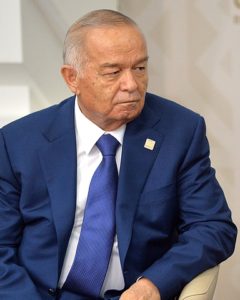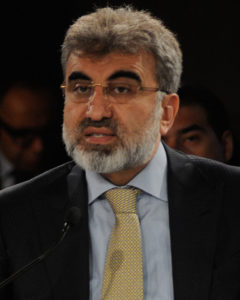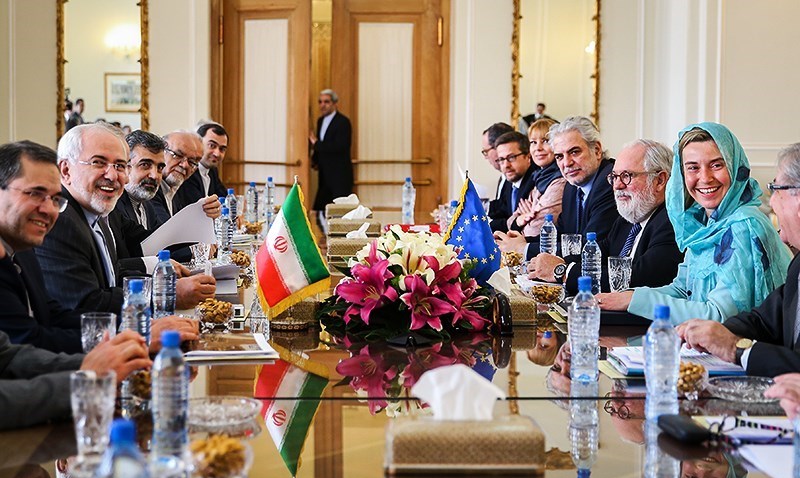Some analysts have immediately began to question why the oil and gas dependence of Europe on Iran is better than the same dependence on Russia. What are the benefits? But their voices – so far! – are not really heard
Problems of Turkmenistan, which we have discussed in the previous part of this study, are not limited to the budget deficit, street protests of the population, the competition between TANAP and TAPI pipelines, and the threats of intrusion of ‘Islamic State’ militants from Afghanistan. The point is also that, according to some experts, the discord in the Turkmen elite is growing. In particular, analysts, who understand the particular characteristic of Turkmenistan in-depth, say that, in this country, the ‘street’ protests are, in principle, impossible without the direct sanction of the certain leaders of the elite.
Turkmen elite, on the one hand, is a part of a complex (and still effective) system of ties based on traditional territorial and tribal unions and conflicts. On the other hand, the same elite has built extensive and multidirectional international contacts during the post-Soviet era, and the comparatively younger (and the most active) part of this elite received education abroad.
As a result, a significant part of the Turkmen elite ended up divided into groups, leaning towards different, sharply conflicting with one another, foreign centers of interest.
The most influential conflicting centers of interest in Turkmenistan are the Turkish, European, American, and Chinese. And some analysts note that, in recent years, Turkish and European centers of interest are losing their supporters among the Turkmen elite, while Chinese and American centers are actively gaining them.
Following the massive street protests of 2014 in Turkmenistan, articles appeared in the world (first of all in the American) press, discussing a possible ‘people’s revolution’ in the Republic under conditions of further deterioration of the socio-economic situation.
Considering the U.S. objective confirmed in early 2015, ‘to maintain presence in Central Asia’, as well as probable appearance of the American weapons, instructors and private military companies (which we have discussed in the previous part of the study) in Turkmenistan in the near future, it cannot be excluded that the maintenance of the U.S. ‘presence in the region’ suggests quite unconventional options.

President of Uzbekistan Islam Karimov in city of Ufa in Russia during the SCO summit
, photo by Kremlin.ru, licensed under CC BY 4.0For example, it is possible that the U.S. can make an attempt to establish major regional ‘bridgehead of presence’ in Turkmenistan as a substitute for Manas Air Base in Kyrgyzstan, which the U.S. has been forced to leave in June 2014. In this regard, it should be noted that despite the announced forthcoming withdrawal of troops from Afghanistan, the Americans were negotiating (so far, without success) the air base in Uzbekistan with Islam Karimov’s government during the whole of 2014 (in September 2015 Karimov forbid establishing foreign military bases in Uzbekistan. However, Karimov died less than a week ago, and the situation might change – Editor).
It cannot also be ruled out that the alleged US contingent in Turkmenistan is required to prepare the background for the ‘color revolution’ in the republic, and it is, of course, no accident that the possibilities for such revolution are already being discussed in the American press. And, most likely, an attempt of the United States to organize a ‘color revolution’ and create ‘the Turkmen bridgehead’ on its basis will be directed against China and its ‘gas expansion’ in the republic.
However, the People’s Republic of China (PRC) fully comprehended and considered the painful and sad lessons learned during the ‘Arab revolutions’ in Libya and Egypt incited by the United States, when China had lost its personnel and investments. Therefore, it is very likely that not only drillers, process engineers, and workers but also specialists of quite military specialization are already working at the Turkmen ‘Galkynysh’ gas field and gas pipelines.
China, of course, understands the role of the United States in the establishment of the Islamic state (ISIL, Organization banned in Russia). China knows that the ‘Caliph’ of the Islamic state al-Baghdadi was prematurely released from the U.S. detention facility as a person, who posed ‘no threat to the national security’ in 2006. China sees the ambiguity of the U.S. actions in the ongoing war with ISIL (Organization banned in Russia), in which the American weapons intended for the war of the ‘moderate Syrian opposition’ against ISIL (Organization banned in Russia) have ‘accidentally’ fallen into the hands of the ‘Caliph’s’ militants. China sees the same ambiguity of the U.S. actions in the ongoing war in Yemen, where the US weapons at a cost of $700 million, delivered to the country to fight against ‘Al-Qaeda’ (Organization banned in Russia) have suddenly ‘gone missing’ and might have fallen into the hands of ‘Al-Qaeda’ (Organization banned in Russia) militants, as the U.S. generals assume.
Finally, China is very carefully studying the development of the situation in Afghanistan. And China knows that Taliban representatives stated that there could be no peace talks with the government of Ashraf Ghani in Kabul after the decision of U.S. President Barack Obama to maintain the U.S. military contingent of ten thousand in Afghanistan until the end of 2015. China knows that many Taliban warlords had already sworn allegiance to the ‘Caliph of ISIL’ (Organization banned in Russia) al-Baghdadi.
Therefore, it can be assumed that China will take appropriate preventive measures against the risk of loss of its investments and the “gas position” in Turkmenistan. That is, China will be prepared to repel the ‘invasion of ISIL’ (Organization banned in Russia) (which may become a pretext for the renunciation of the neutrality traditional in Turkmenistan and ‘saving’ invitation of the United States and NATO troops into the Republic), and to block ‘color revolutionary’ excesses.
Central Asian ‘gas situation’ and the factor of Iran
A ‘breakthrough’ in talks on Iran’s nuclear program, announced in the end of March 2015, which raised the hopes for the lifting of the international economic sanctions imposed on Tehran (the article was written in April 2015, and UN sanctions were lifted on January 16th 2016 – Editor), dramatically changed the manner in which the discussions on the global oil and gas market prospects is conducted.
Iran has approximately 10% of the global oil reserves and about 20% of global gas reserves. This is why world press became full of statements made by many politicians and economists on huge Iranian energy resources ‘about’ to appear on the markets. As a result, the global oil and gas prices would collapse and remain at a low level for a long time… Presumably, this would quickly destroy the economy of the ‘aggressive Putin’s Russia’… And the Russian gas pipeline ‘Turkish Stream’ would be useless. And Europe will finally be able to get rid of the burdensome oil and gas dependency upon Russia…
Some analysts have immediately questioned why the oil and gas dependence of Europe on Iran is better than the same dependence on Russia. What are the benefits? But their voices – so far! – are not really heard
So far, the voices of those, who hasten to declare the ‘incredible flexibility’ of the Americans during the talks with Iran as ‘an obvious symptom of the growing weakness of the world’s only superpower’, sound louder. They say that the U.S. are unable to resolve so many of regional conflicts, and, therefore, the Americans are retreating, losing face and recognizing that the terror of the ‘Islamic State’ cannot be suppressed without the help of Iran.
It seems that such arguments about the weakness of the U.S. are premature. But we shall discuss this point later. Here, we shall consider very significant new trends on the ‘gas front’, which is the subject matter of our analysis.
Azerbaijan was one of the first countries, which reacted to the news concerning Iran.
On April 4th, the President of the State Oil Company of Azerbaijan Republic (SOCAR) Rovnag Abdullayev said that “…if Iran increases gas production volumes, then TANAP pipeline (from Azerbaijan through Georgia and Turkey to Europe – Editor) is the only alternative for the delivery of the Iranian gas to the markets…“. And at the same time, Abdullayev said that SOCAR is ready to sell a part of its share in the TANAP pipeline project to new participants if there are attractive offers.
On April 7, Turkish President Recep Tayyip Erdoğan paid a visit to Iran, for the first time in a while. Details of the talks did not appear in the press. But the press cited a very important statement made by Erdogan at a joint press conference with Iranian President Hassan Rouhani following the talks. Erdoğan said that “Turkey and Iran have to become mediators in the conflicts in Syria and Iraq to stop the bloodshed in these countries.” Considering the ‘polar’ positions of Ankara and Tehran on the war in Syria, such statement can be considered a breakthrough.
On April 9, the then Energy Minister of Turkey Taner Yildiz, commenting on the statement of the SOCAR President

Taner Yildiz, Minister of Energy and Natural Resources of Turkey between 2009 and 2015
, photo by World Economic Forum, licensed under CC BY-NC-SA 2.0Abdullayev on the possibility of Iran joining the TANAP project, announced that Turkey is ready to sell a part of its share in the project.
It is unclear whether Azerbaijani or Turkish share in the project would be sold to Iran. However, not everyone in Azerbaijan is glad about the prospect of competition with Iran in the TANAP pipeline. For example, the Director of the Caspian Barrel Energy-Research Center Ilham Shaban said, “Baku is not building TANAP to export 20 billion cubic meters (bcm) of Iranian gas and 10 bcm of its own, or 10 bcm of Iranian gas, 10 bcm of Turkmen gas, and 10 bcm of gas from ‘Shah-Deniz’. In this case, how are we supposed to export gas from ‘Absheron’, ‘Umid’ gas fields, and the deepwater portion of ACG gas field (‘Azeri-Chirag-Gu
Note that TANAP pipeline is not the only option for the Iranian gas export to Europe. Iran already has a line of ‘Tabriz-Ankara’ gas pipeline to Turkey with the capacity of 14 bcm per year. This line is designed as a part of the ‘large’ ‘Pars’ gas pipeline network with the capacity of 37 bcm of gas per year to supply Europe with the Iranian gas of ‘South Pars’ gas field through Turkey. It is possible that Erdoğan’s talks in Tehran have touched upon the issue of resuming the ‘Pars’ project. And this is exactly the reason of Taner Yildiz’s statement on the readiness to sell the Turkish share in TANAP project (not that interesting to Ankara anymore).
But resuming ‘Pars’ project could be not so problem-free.
First of all, the pipeline passes through the ‘troubled’ Kurdish territory, and the serious sabotages are already occurred on ‘Tabriz-Ankara’ more than once. That is, the realization of the ‘Pars’ project will require the difficult negotiations on the commercial and, perhaps, policy preferences, which Kurdish elites and the Kurdish population in the region will receive from the gas transit.
The second point is that the implementation of the ‘Pars’ project will almost certainly mean the end of an alternative ‘Qatari gas pipeline’ to Europe, which we have discussed earlier in this study, and, which Qatar wants to build through Saudi Arabia, Jordan, Syria, and Turkey. And it is unlikely that the Arab states of the Persian Gulf will be calm about the prospect of letting their hated rival Iran get a huge part of the European gas market.
Also on April 9, the ‘gas suspense’ around Iran was also supplemented by another sensational news. The Wall Street Journal reported, citing the State officials in Islamabad, that China, despite the U.S. objections, intends to build a gas pipeline ‘Peace’, 700 km of length, for the gas supplies to Pakistan from Iran. ‘Peace’ pipeline was started as ‘Iran-Pakistan-I
According to Tehran, the Iranian section of the pipeline is almost ready. The agreement on the updated project of ‘Peace’ pipeline is expected to be signed in April 2015. And a Chinese state-owned oil and gas corporation CNPC (the one, which manages the Chinese gas projects in Turkmenistan and is the main rival of the American project of TAPI gas pipeline to Pakistan, alternative to ‘Peace’ pipeline) is ready not only to build ‘Peace’, but also to provide 85% of total investments for this.
To be continued.
Source (for copy): https://eu.eot.su/?p=8442
This is the translation of the ninth article (first published in “Essence of Time” newspaper issue 123 on April 15, 2015) by Yury Byaly of a series on the new round of global economic warfare. The ultimate goal of this war, of which gas wars is a part, is the weakening and dissolution of Russia. But disruption of Russian supply of gas will lead to lack of gas and rise of prices and some European economies might just not handle this. Since all of the global economy is intertwined, those who started this war want to make not just Russia, but many other countries become weaker in the end.




